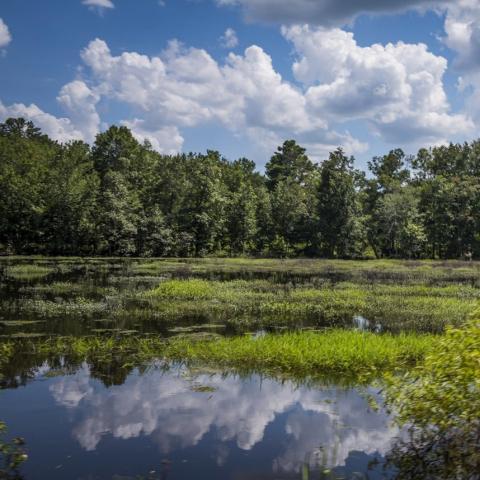The Natural Resources Conservation Service is responsible for providing program participants technical assistance and determinations to assist them in complying with USDA conservation compliance regulations.
To maintain eligibility for most USDA programs, producers must comply with the Highly Erodible Land Conservation (HELC) and Wetland Conservation (WC) provisions, agreeing they will not:
- Produce an agricultural commodity on highly erodible land without an adequate conservation system;
- Plant an agricultural commodity on a converted wetland;
- Convert a wetland to make possible the production of an agricultural commodity.
The Natural Resources Conservation Service (NRCS) is responsible for providing program participants technical assistance and determinations to assist them in complying with the provisions.
Compliance Resources
- Lateral Effect Distances for the Prairie Pothole Region
- Overview - Compliance, Appeals, Mediation, Relief
- Conservation Compliance Glossary
- Highly Erodible Land (HEL) Soils Determination
Conservation Compliance and Mitigation Banking
What Is Mitigation Banking?
Wetland mitigation banking is the restoration, creation or enhancement of wetlands for the purpose of compensating for unavoidable impacts to wetlands at another location. Wetland mitigation banking is commonly used to compensate for wetland impacts from development, but it also used for impacts from agriculture.
Conservation compliance provisions for wetlands, commonly called Swampbuster provisions, aim to remove certain incentives to produce agricultural commodities on converted wetlands. Producers seeking benefits through most USDA programs must meet conservation compliance by filing form AD-1026, affirming they will not drain, dredge or fill wetlands in order to grow commodity crops. In situations where avoidance or on-site mitigation is challenging, the Farm Bill allows for off-site mitigation through mitigation banking.
How does Mitigation Banking work?
Producers can buy credits from wetlands mitigation banks to compensate for the impact of lost wetlands. Wetland mitigation banks are established through the restoration, creation or enhancement of wetlands. When a mitigation bank is established, the landowner retains ownership and use of the property, while a conservation easement protects the wetlands from degrading activities. The size and scope of the wetland restoration, creation or enhancement activities determine the quantity of credits available for sale. The price of credits is negotiated between the buyer and seller.
For NRCS, the National Food Security Act Manual outlines the mitigation requirements for conservation compliance. See NRCS Mitigation for more information about compliance for wetlands.
How are Mitigation Banks developed?
Bank sponsors develop mitigation banks. A bank sponsor is any individual or entity that develops wetlands for use in wetland mitigation banking. The sponsor is responsible for the cost of wetland development, as well as long-term maintenance to ensure that the wetland continues to function as designed in the future.
Credits are determined using a functional assessment procedure that evaluates individual wetland functions. As the credits are sold, they are subtracted from the bank until all of the available credits are purchased. At this time, the mitigation bank closes and no additional credits can be sold from that bank.
What land qualifies for Mitigation Banks?
Only wetlands that have been restored, enhanced or created can qualify as a site for wetland mitigation banks. Preserving existing wetlands does not qualify as this does not produce replacement acres of wetlands. Bank sponsors should consider the credit market in the local area to determine whether the bank would be best suited to provide agriculture credits.
As a general rule, former wetlands restored to their original condition provide the best chance for success in generating wetland functions and values. Next best is wetland enhancement, and lastly, wetland creation on land without a prior history of wetland conditions. Long-term success and stability are important considerations, since the bank sponsor is required to provide long-term site maintenance to ensure it continues to function as designed.
Contact
Additional Information
Conservation Compliance for Highly Erodible Land
The Food Security Act’s highly erodible land (HEL) provisions were enacted to protect the Nation’s long-term capability to produce food and fiber.
Learn MoreConservation Compliance for Wetlands
The Food Security Act’s wetland conservation provisions were enacted to assist in protecting the values, acreage, and functions of the Nation's wetlands.
Learn More

